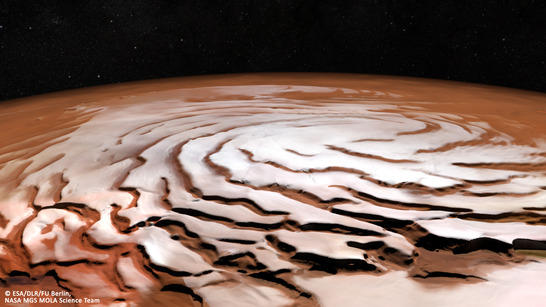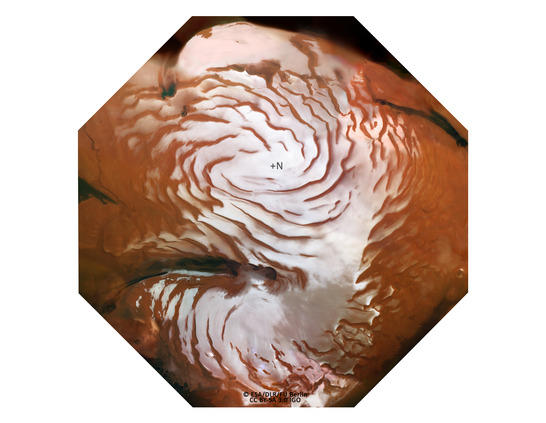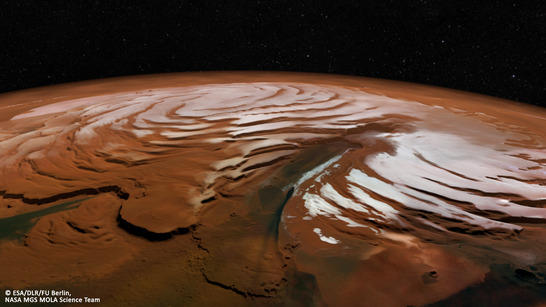Clear view of the Mars north polar ice cap
Beginning of 2017 corresponds to northern hemisphere winter season on Mars. A new High Resolution Stereo Camera (HRSC) color image mosaic, generated out of 32 individual orbit stripes, reveals the beauty of the northern ice cap of Mars. The HRSC experiment is carried by the ESA Mars Express Orbiter and operated by the German Aerospace Center (Deutsches Zentrum für Luft- und Raumfahrt; DLR). The mosaic was created by the Planetary Sciences and Remote Sensing group at Freie Universität Berlin. The systematic processing of the HRSC image data was carried out at DLR.

North Polar Ice Cap perspective
• Fullscreen, Pan and Zoom • Download high resolution
The pictured permanent north polar ice cap of Mars is composed of water ice and dust and covers an area of approximately 1x106 km². The volume of the permanent cap is estimated to be 1.2x106 km³, about half the size of the Greenland ice cap on Earth. The ice cap has an average thickness of approximately two kilometres. Temperatures fall to below -125 degrees Celsius during the Martian winter, which is twice as long as Earth's due to Mars' two-year orbital period and is characterised by long polar nights due to the tilt of its rotational axis. Only in the Martian winter season, temperatures are cold enough for carbon dioxide to precipitate from the atmosphere, forming an additional seasonal cap of carbon dioxide ice.
Characteristic features of the north polar cap are the dark troughs that spiral outward from the pole in counterclockwise direction, and a prominent trench at about 300°E with a length of 500 km and a width of up to 100 km, termed Chasma Boreale.

North Polar Ice Cap color image
• Fullscreen, Pan and Zoom • Download high resolution
Radar investigations of the north polar cap were performed by MARSIS on Mars Express and by SHARAD on Mars Reconnaissance Orbiter. They show that the ice cap is made up of many individual layers that are considered a valuable archive for the climate of Mars during the past millions of years. Some radar data hint to wind transport and atmospheric deposition as dominant processes for the formation of the spiral troughs and trenches.

North Polar Ice Cap perspective 2
• Fullscreen, Pan and Zoom • Download high resolution
Image processing and the HRSC experiment on Mars Express
The mosaic consists of 32 orbit stripes (1154, 1177, 1219, 1291, 1394, 1745, 3663, 3681, 3685, 3695, 5483, 5775, 5784, 5796, 5808, 5810, 5818, 5824, 5827, 5838, 5853, 5864, 5867, 5900, 5904, 5963, 6007, 6229, 8042, 8080, 8153, 8160) and covers a region 0°-360° East and approximately 78° to 90° North. The images were acquired mainly during the summer seasons, since images of the winter ice cap suffer from CO2 cloud covering and dust, and are thus unsuitable for mosaic production. The color mosaic was created using data from the nadir channel, the field of view of which is aligned perpendicular to the surface of Mars, and the color channels of the HRSC. The oblique perspective views were generated using elevation data from the Mars Orbiter Laser Altimeter (MOLA) experiment on board the NASA Mars Global Surveyor mission. The context map is in stereographic projection and uses a Mars sphere as reference body for elevation values.
Copyrights
HRSC image in top view: ESA/DLR/FU Berlin, CC BY-SA 3.0 IGO
Perspective views: ESA/DLR/FU Berlin, NASA MGS MOLA Science Team
Copyright Notice:
Where expressly stated, images are licenced under the Creative Commons Attribution-ShareAlike 3.0 IGO (CC BY-SA 3.0 IGO) licence. The user is allowed to reproduce, distribute, adapt, translate and publicly perform it, without explicit permission, provided that the content is accompanied by an acknowledgement that the source is credited as 'ESA/DLR/FU Berlin', a direct link to the licence text is provided and that it is clearly indicated if changes were made to the original content. Adaptation/translation/derivatives must be distributed under the same licence terms as this publication.
The High Resolution Stereo Camera was developed at the German Aerospace Center (DLR) and built in collaboration with partners in industry (EADS Astrium, Lewicki Microelectronic GmbH and Jena-Optronik GmbH). The science team, which is headed by Principal Investigator (PI) Ralf Jaumann, consists of 52 co-investigators from 34 institutions and 11 countries. The camera is operated by the DLR Institute of Planetary Research in Berlin-Adlershof.